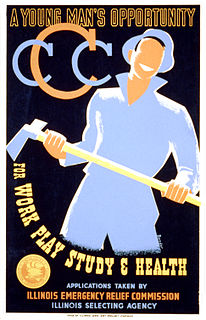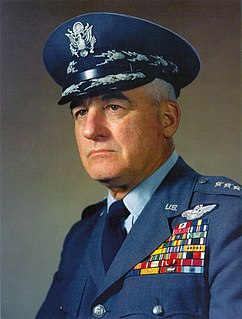Related Research Articles

The Civilian Conservation Corps (CCC) was a voluntary public work relief program that ran from 1933 to 1942 in the United States for unemployed, unmarried men ages 18–25 and eventually expanded to ages 17–28. Robert Fechner was the first director of this agency, succeeded by James McEntee following Fechner's death. The CCC was a major part of President Franklin D. Roosevelt's New Deal that supplied manual labor jobs related to the conservation and development of natural resources in rural lands owned by federal, state, and local governments. The CCC was designed to supply jobs for young men and to relieve families who had difficulty finding jobs during the Great Depression in the United States. The largest enrollment at any one time was 300,000. Through the course of its nine years in operation, three million young men took part in the CCC, which provided them with shelter, clothing, and food, together with a wage of $30 per month.

The Legion of Merit (LOM) is a military award of the United States Armed Forces that is given for exceptionally meritorious conduct in the performance of outstanding services and achievements. The decoration is issued to members of the eight uniformed services of the United States as well as to military and political figures of foreign governments.
Military science is the study of military processes, institutions, and behavior, along with the study of warfare, and the theory and application of organized coercive force. It is mainly focused on theory, method, and practice of producing military capability in a manner consistent with national defense policy. Military science serves to identify the strategic, political, economic, psychological, social, operational, technological, and tactical elements necessary to sustain relative advantage of military force; and to increase the likelihood and favorable outcomes of victory in peace or during a war. Military scientists include theorists, researchers, experimental scientists, applied scientists, designers, engineers, test technicians, and other military personnel.

A veteran is a person who has significant experience and expertise in a particular occupation or field. A military veteran is a person who is no longer serving in a military.
A physician assistant (PA) is a type of mid-level health care provider. PAs may diagnose illnesses, develop and manage treatment plans, prescribe medications, and may serve as a principal healthcare provider. PAs are required in nearly all states to have a direct agreement with a physician for supervision and collaboration.

Nathan Farragut Twining was a United States Air Force general, born in Monroe, Wisconsin. He was the chief of Staff of the United States Air Force from 1953 until 1957, and the third chairman of the Joint Chiefs of Staff from 1957 to 1960. He was the first member of the Air Force to serve as Chairman. Twining was a distinguished "mustang" officer, rising from private to four-star general and appointment to the highest post in the United States Armed Forces in the course of his 45-year career.
Lesbian, gay, bisexual, transgender, and queer (LGBTQ) personnel are able to serve in the armed forces of some countries around the world: the vast majority of industrialized, Western countries, in addition to South Africa, and Israel. The rights concerning intersex people are more vague.

The Smith & Wesson Model 10, previously known as the Smith & Wesson .38 Hand Ejector Model of 1899, the Smith & Wesson Military & Police or the Smith & Wesson Victory Model, is a K-frame revolver of worldwide popularity. In production since 1899, the Model 10 is a six-shot, .38 Special, double-action revolver with fixed sights. Over its long production run it has been available with barrel lengths of 2 in (51 mm), 2.5 in (64 mm), 3 in (76 mm), 4 in (100 mm), 5 in (130 mm), and 6 in (150 mm). Barrels of 2.5 inches (64 mm) are also known to have been made for special contracts. Some 6,000,000 of the type have been produced over the years, making it the most popular handgun of the 20th century.

Military recruitment refers to the activity of attracting people to, and selecting them for, military training and employment.

Southern Wisconsin Regional Airport is a public airport located southwest of Janesville and north of Beloit in Rock County, Wisconsin, United States. Formerly known as Rock County Airport, it is owned and operated by the Rock County government. The airport has no scheduled commercial passenger service.

Racial segregation in the United States is the segregation of facilities and services such as housing, medical care, education, employment, and transportation in the United States along racial lines. The term mainly refers to the legally or socially enforced separation of African Americans from whites, but it is also used with regard to the separation of other ethnic minorities from majority mainstream communities. While mainly referring to the physical separation and provision of separate facilities, it can also refer to other manifestations such as prohibitions against interracial marriage, and the separation of roles within an institution. Notably, in the United States Armed Forces up until 1948, black units were typically separated from white units but were still led by white officers.

The Wisconsin Historical Society is simultaneously a state agency and a private membership organization whose purpose is to maintain, promote and spread knowledge relating to the history of North America, with an emphasis on the state of Wisconsin and the trans-Allegheny West. Founded in 1846 and chartered in 1853, it is the oldest historical society in the United States to receive continuous public funding. The society's headquarters are located in Madison, Wisconsin, on the campus of the University of Wisconsin–Madison.

Military personnel are members of the state's armed forces. Their roles, pay, and obligations differ according to their military branch, rank, and their military task when deployed on operations and on exercise.

The term military medicine has a number of potential connotations. It may mean:

The 126th Air Refueling Squadron is a unit of the 128th Air Refueling Wing of the Wisconsin Air National Guard stationed at General Mitchell Air National Guard Base, Wisconsin. The 126th is equipped with the KC-135R Stratotanker.

Military sociology is a subfield within sociology. It corresponds closely to C. Wright Mills's summons to connect the individual world to broader social structures. Military sociology aims toward the systematic study of the military as a social group rather than as a military organization. This highly specialized sub-discipline examines issues related to service personnel as a distinct group with coerced collective action based on shared interests linked to survival in vocation and combat, with purposes and values that are more defined and narrow than within civil society. Military sociology also concerns civil-military relations and interactions between other groups or governmental agencies.

The United States Army Air Forces was the major land-based aerial warfare service component of the United States Army and de facto aerial warfare service branch of the United States during and immediately after World War II (1941–1945). It was created on 20 June 1941 as successor to the previous United States Army Air Corps and is the direct predecessor of the United States Air Force, today one of the six armed forces of the United States. The AAF was a component of the United States Army, which on 2 March 1942 was divided functionally by executive order into three autonomous forces: the Army Ground Forces, the United States Army Services of Supply, and the Army Air Forces. Each of these forces had a commanding general who reported directly to the Army Chief of Staff.

Ralph Austin Bard was a Chicago financier who served as Assistant Secretary of the Navy, 1941–1944, and as Under Secretary, 1944–1945. He is noted for a memorandum he wrote to Secretary of War Henry L. Stimson in 1945 urging that Japan be given a warning before the use of the atomic bomb on a strategic city. He was "the only person known to have formally dissented from the use of the atomic bomb without advance warning."

La Vern E. Weber was a United States Army officer who served as Adjutant General of Oklahoma, Director of the Army National Guard and Chief of the National Guard Bureau (NGB). He was the first NGB Chief to hold the rank of lieutenant general.
Felix M. Keesing was a New Zealand-born anthropologist who specialized in the study of the Philippine Islands and the South Pacific. He came to the United States in the 1940s and taught at Stanford University, California, 1942–1961.
References
- ↑ Espy, Herbert G. (January 1945). "The program of the United States Armed Forces Institute". Journal of Chemical Education. 22 (1): 26. doi:10.1021/ed022p26. ISSN 0021-9584.
- ↑ Little, Roger William (1969). Selective service and American society, 1922–2005. New York: Russell Sage Foundation. p. 170. ISBN 9781610446648. OCLC 907642602.
- ↑ "Exams Program Guide" (PDF). DANTES. 2014. p. 34.
- ↑ Palmer, Miles R. (1955). "The United States Armed Forces Institute". Public Administration Review. 15 (4): 272–274. doi:10.2307/972982. JSTOR 972982.
- ↑ "United States Armed Forces Institute | Photograph". Wisconsin Historical Society. 2008-09-30. Retrieved 2018-09-29.